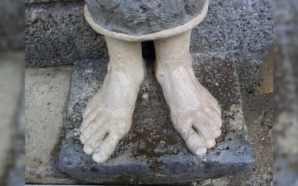As we imagine the scene of the first Palm Sunday, we can’t miss the disconnection between what we see with our eyes and the high meaning it proclaims. We see a man seated precariously on a barrel-like ass, accompanied by a raggle-taggle group of bystanders waving green tree fronds, as he makes his way through the dust into town.
What it means is that the King of Israel has arrived for his installation. This is dynastic history played as comedy.
This contrast between appearance and reality makes Palm Sunday the right day to remember people who have sought protection in Australia.
They, too, have come to Australia in mockeries of boats and have tried to enter through its sea gates. They, too, have been captured on arrival and hung out in prisons in order to deter others.
As on the first Palm Sunday, a handful of Catholics will gather this year to march with others through their city streets. In Melbourne, they will include people from Jesuit Social Services and Catholic Alliance for People Seeking Asylum.
They will march under banners insisting that these people are human beings like ourselves and demand respect. As they did on the first Palm Sunday, and have done for many years, bystanders will stop to watch for a minute or two and pass on, perhaps moved to reflection, perhaps dismissive of such puny challenges to a powerful State.
Yet, year by year the marches continue, gathering people who are still seeking protection, their relatives, and people who are horrified that our fellow human beings are suffering so in the name of Australia.
For Christians who march, Palm Sunday is a holy day. It expresses their belief that Jesus’ way lay through suffering, torture and death to the exuberant life in which we share. What began in the humanly comic scene on Palm Sunday and continued in the humanly serious and brutal business of Good Friday, concluded in the divine comedy of Easter Sunday and its victory over the forces of death-dealing.
The Palm Sunday celebrations and marches remind us that the story of Jesus’ life, death and rising does not remain in the past, but continues to be a compass bearing for our lives today. It reminds us, too, that governments can treat human beings badly, can preside over their descent into mental illness, isolation and despair, but that they cannot deprive even the most neglected and unlikeable of people of their dignity as human beings, each of whom matters and is precious to God.
It reminds us, too, that we are bound to one another and that all other persons’ suffering is also our own; that, just as Jesus shared the life and death of people who were disregarded and seen as expendable, so we are called to allow the pain and desperation of people who seek protection to touch us and to move us to stand with them.
At the Palm Sunday marches, we may seem to be few, as were those who remained with Jesus during his Passion. In reality, however, we are many, linked with all those through history who have hungered and thirsted for justice and for freedom for those enchained.
In Catholic Churches on Palm Sunday, we hold green branches. Green is the colour of the springtime growth and promise that follow the chill of winter. The Palm Sunday March is held during the winter of the spirit, but it expresses our hope that people left to rot will be freed and will live with us.
Fr Andrew Hamilton SJ writes for Jesuit Communications and Jesuit Social Services.








